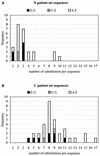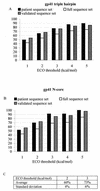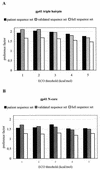Comparison of predicted scaffold-compatible sequence variation in the triple-hairpin structure of human imunodeficiency virus type 1 gp41 with patient data
- PMID: 12097573
- PMCID: PMC136393
- DOI: 10.1128/jvi.76.15.7595-7606.2002
Comparison of predicted scaffold-compatible sequence variation in the triple-hairpin structure of human imunodeficiency virus type 1 gp41 with patient data
Abstract
It has been proposed that the ectodomain of human immunodeficiency virus type 1 (HIV-1) gp41 (e-gp41), involved in HIV entry into the target cell, exists in at least two conformations, a pre-hairpin intermediate and a fusion-active hairpin structure. To obtain more information on the structure-sequence relationship in e-gp41, we performed in silico a full single-amino-acid substitution analysis, resulting in a Fold Compatible Database (FCD) for each conformation. The FCD contains for each residue position in a given protein a list of values assessing the energetic compatibility (ECO) of each of the 20 natural amino acids at that position. Our results suggest that FCD predictions are in good agreement with the sequence variation observed for well-validated e-gp41 sequences. The data show that at a minECO threshold value of 5 kcal/mol, about 90% of the observed patient sequence variation is encompassed by the FCD predictions. Some inconsistent FCD predictions at N-helix positions packing against residues of the C helix suggest that packing of both peptides may involve some flexibility and may be attributed to an altered orientation of the C-helical domain versus the N-helical region. The permissiveness of sequence variation in the C helices is in agreement with FCD predictions. Comparison of N-core and triple-hairpin FCDs suggests that the N helices may impose more constraints on sequence variation than the C helices. Although the observed sequences of e-gp41 contain many multiple mutations, our method, which is based on single-point mutations, can predict the natural sequence variability of e-gp41 very well.
Figures







Similar articles
-
Six-helix bundle completion in the distal C-terminal heptad repeat region of gp41 is required for efficient human immunodeficiency virus type 1 infection.Retrovirology. 2018 Apr 2;15(1):27. doi: 10.1186/s12977-018-0410-9. Retrovirology. 2018. PMID: 29609648 Free PMC article.
-
Design and properties of N(CCG)-gp41, a chimeric gp41 molecule with nanomolar HIV fusion inhibitory activity.J Biol Chem. 2001 Aug 3;276(31):29485-9. doi: 10.1074/jbc.C100317200. Epub 2001 Jun 19. J Biol Chem. 2001. PMID: 11418583
-
Statistical correlation of nonconservative substitutions of HIV gp41 variable amino acid residues with the R5X4 HIV-1 phenotype.Virol J. 2016 Feb 16;13:28. doi: 10.1186/s12985-016-0486-6. Virol J. 2016. PMID: 26879054 Free PMC article.
-
N- and C-domains of HIV-1 gp41: mutation, structure and functions.Immunol Lett. 2001 Jan 15;75(3):215-20. doi: 10.1016/s0165-2478(00)00302-3. Immunol Lett. 2001. PMID: 11166378 Review.
-
Efficient Fusion at Neutral pH by Human Immunodeficiency Virus gp41 Trimers Containing the Fusion Peptide and Transmembrane Domains.Biochemistry. 2018 Feb 20;57(7):1219-1235. doi: 10.1021/acs.biochem.7b00753. Epub 2018 Feb 6. Biochemistry. 2018. PMID: 29345922 Free PMC article.
Cited by
-
Novel ring structure in the gp41 trimer of human immunodeficiency virus type 1 that modulates sensitivity and resistance to broadly neutralizing antibodies.J Virol. 2009 Aug;83(15):7728-38. doi: 10.1128/JVI.00688-09. Epub 2009 May 27. J Virol. 2009. PMID: 19474108 Free PMC article.
References
-
- Beirnaert, E., P. Nyambi, B. Willems, L. Heyndrickx, B. Colebunders, W. Janssens, and G. van der Groen. 2000. Identification and characterization of sera from HIV-infected individuals with broad cross-neutralizing activity against group M (env clade A-H) and group O primary HIV-1 isolates. J. Med. Virol. 61:14-24. - PubMed
-
- Bernstein, F. C., T. F. Koetzle, G. J. B. Williams, E. F. Meywe, Jr., M. D. Brice, J. R. Rodgers, O. Kennard, T. Shimanoushi, and M. Tasumi. 1977. The Protein Data Bank: a computer-based archival file for macromolecular structures. J. Mol. Biol. 112:535-542. - PubMed
-
- Buzko, O. V., and K. M. Shokat. 1999. Blocking HIV entry. Nat. Struct. Biol. 6:906-908. - PubMed
Publication types
MeSH terms
Substances
Associated data
- Actions
- Actions
- Actions
- Actions
- Actions
- Actions
- Actions
- Actions
- Actions
- Actions
- Actions
- Actions
- Actions
- Actions
- Actions
- Actions
- Actions
- Actions
- Actions
- Actions
- Actions
- Actions
- Actions
- Actions
- Actions
- Actions
- Actions
- Actions
- Actions
- Actions
- Actions
- Actions
- Actions
- Actions
- Actions
LinkOut - more resources
Full Text Sources
Molecular Biology Databases

